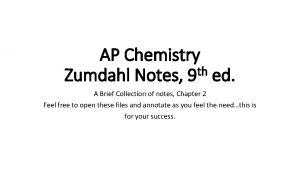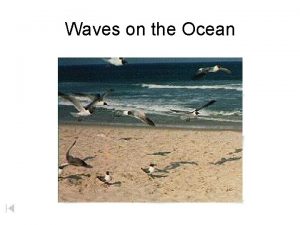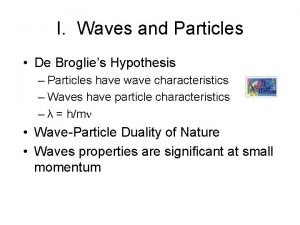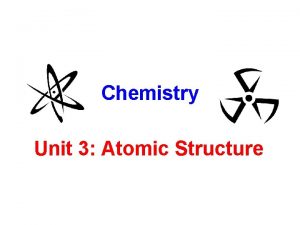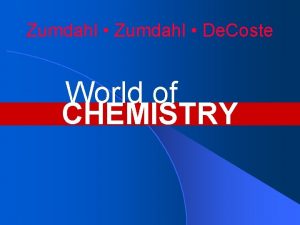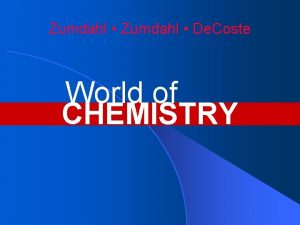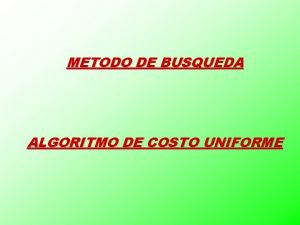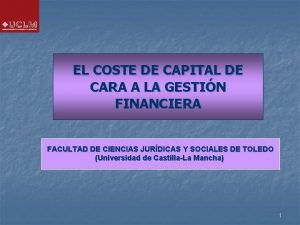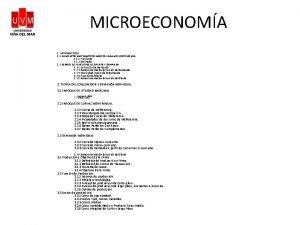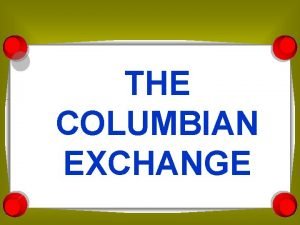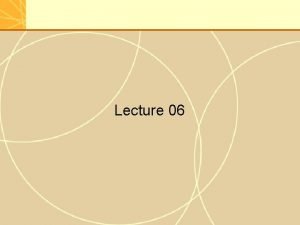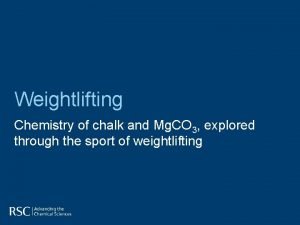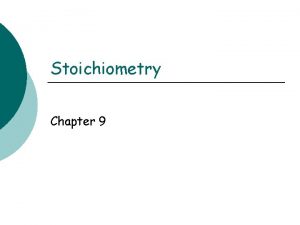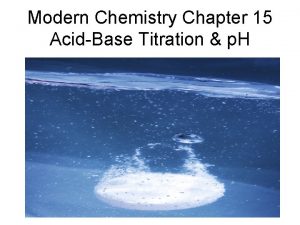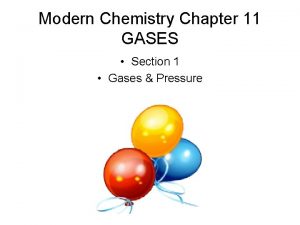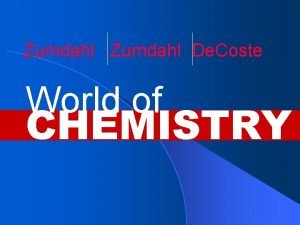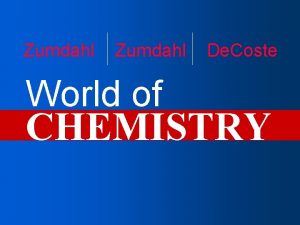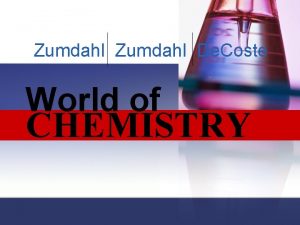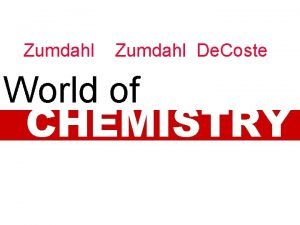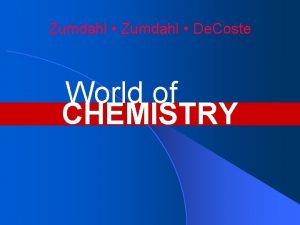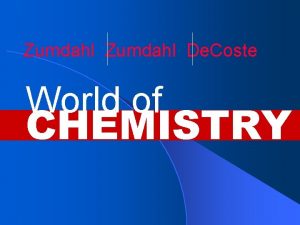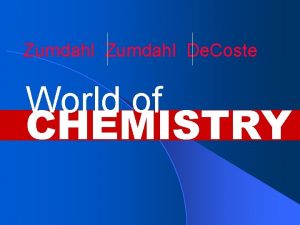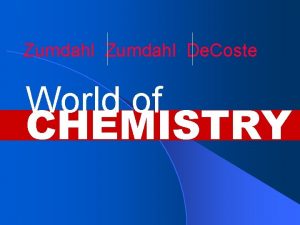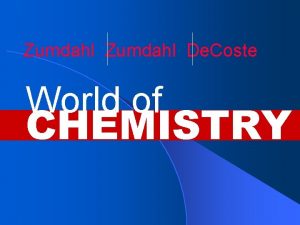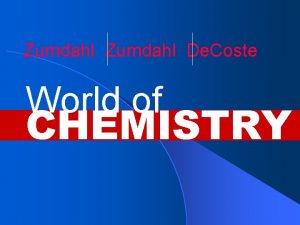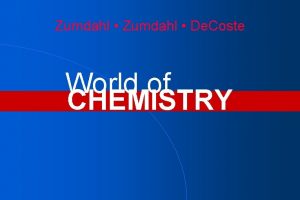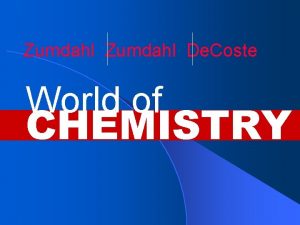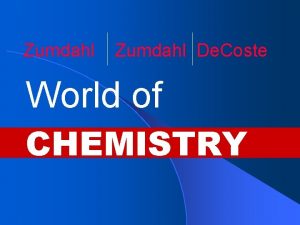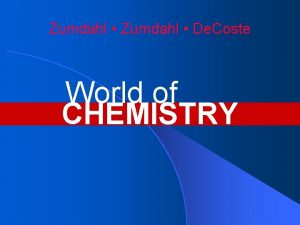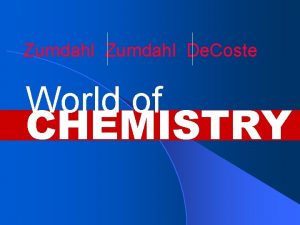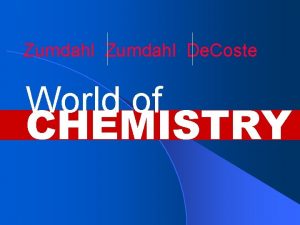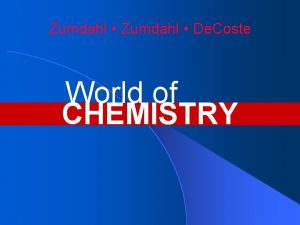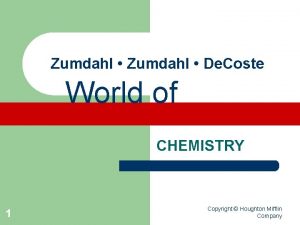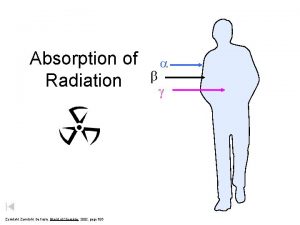Zumdahl De Coste World of CHEMISTRY Chapter 9









































- Slides: 41

Zumdahl • De. Coste World of CHEMISTRY

Chapter 9 Chemical Quantities

Goals of Chapter 9 • • Understand molecular and molar mass given in balanced equation Use balanced equation to determine the relationships between moles of reactants and moles of products Relate masses of reactants and products in a chemical reaction Perform mass calculations that involve scientific notation Understand the concept of limiting reactants Recognize the limiting reactant in a reaction Use the limiting reactant to do stoichiometric calculations

Information Given by Chemical Equations • �Reactions are described by equations • Give the identities of the reactants & products • Show much of each reactant and product participates in the reaction. • Numbers or coefficients enable us to determine how much product we get from a given quantity of reactants

Information Given by Chemical Equations Atoms are rearranged in a chemical reaction (not created or destroyed) • Must have same number of each type of atom on both sides of equation. • Coefficients give relative number of molecules, meaning we can multiply by any number and still have a balanced equation. •

Table 9. 1

Combustion of Propane reacts with oxygen to produce heat and the products carbon dioxide and water: C 3 H 8(g) + 5 O 2(g) → 3 CO 2(g) + 4 H 2 O(g)

Interpretation of Equation 1 molecule of C 3 H 8 reacts with 5 molecules of O 2 to give 3 molecules of CO 2 plus 4 molecules of H 2 O • 1 mole of C 3 H 8 reacts with 5 moles of O 2 to give 3 moles of CO 2 plus 4 moles of H 2 O •

Nuts & Bolts of Chemistry Activity • 2 Nuts (N) react with 1 bolt (B) to form a nutbolt molecule • • 2 N + B → N 2 B Note difference between coefficient and subscript Construct nut-bolt molecules Which is limiting reactant? Why?

Average mass of bolt = 10. 64 g & average mass of nut = 4. 35 g; If you are given about 1500 g of each, answer the following questions: 1. How many bolts are in 1500 g? How many nuts are in 1500 g? 2. Which is limiting reactant? Why? 3. What is largest possible mass of product? How many products can you make? 4. What is mass of leftover reactant?

Mole-Mole Relationships 2 H 2 O(l) → 2 H 2(g) + O 2(g) Equation tells us that 2 mol of H 2 O yields 2 mol of H 2 and 1 mol of O 2 If we decompose 4 mol of water, how many moles of products do we get? 4 H 2 O(l) → 4 H 2(g) + 2 O 2(g) If we decompose 5. 8 mol of water, how many moles of products do we get? 5. 8 H 2 O(l) → 5. 8 H 2(g) + ? O 2(g)

Mole Ratios: conversion factors based on balanced chemical equations From initial equation: 2 mol H 2 O = 2 mol H 2 = 1 mol O 2 Can use equivalent statement & perform dimensional analysis 5. 8 mol H 2 O x 1 mol O 2_ = 2. 9 mol O 2 2 mol H 2 O

Mass Calculations What mass of oxygen (O 2) is required to react with exactly 44. 1 g of propane (C 3 H 8)?

Step 1: Write balanced equation C 3 H 8(g) + 5 O 2(g) → 3 CO 2(g) + 4 H 2 O(g)

Step 2: Convert grams of propane to moles of propane 44. 1 g C 3 H 8 x 1 mol C 3 H 8 = 1. 00 mol C 3 H 8 44. 09 g C 3 H 8

Step 3: Use coefficients in equation to determine moles of oxygen required 1. 00 mol C 3 H 8 x 5 mol O 2 = 5. 00 mol O 2 1 mol C 3 H 8

Step 4: Use molar mass of O 2 to calculate the grams of oxygen 5. 00 mol O 2 x 32. 0 g O 2 = 160 g O 2 1. 00 mol O 2

Can perform conversion in on long step: 44. 1 g C 3 H 8 x 1 mol C 3 H 8 44. 09 g C 3 H 8 x 5 mol O 2 x 32. 0 g O 2 = 160 g O 2 1 mol C 3 H 8 1. 00 mol O 2

• • • Mass Calculations Using Scientific Notation Step 1: Balance the equation for the reaction Step 2: Convert the masses of reactants or products to moles Step 3: Use the balanced equation to set up the appropriate mole ratio(s) Step 4: Use the mole ratio(s) to calculate the number of moles of the desired product or reactant. Step 5: Convert from moles back to mass

Stoichiometry The process of using a chemical equation to calculate the relative masses of reactants and products involved in a reaction

Mass Calculations: Comparing Two Reactions • Antacids are used to neutralize excess hydrochloric acid secreted by the stomach. Which antacid is more effective: baking soda, Na. HCO 3, or milk of magnesia, Mg(OH)2? • Determine how many moles of stomach acid (HCl) will react with 1. 00 g of each acid.

The Concept of Limiting Reactants

Consider the reaction that forms ammonia: N 2(g) + 3 H 2(g) → 2 NH 3(g) These gases are mixed in a closed vessel and begin to react

Container (#1) of N 2(g) and H 2(g).

Before and after the reaction.

This reaction contained the exact number of molecules to make ammonia molecules with no unreacted molecules left over. Before the reaction, there were 15 H 2 molecules and 5 N 2 molecules which gives the exact ratio to make ammonia, 3: 1. This type of mixture is called a stoichiometric mixture – contains the relative amounts of reactants that matches the numbers in balanced equation

What happens when the ratio is not the same as in the chemical equation?

Container (#2) of N 2(g) and H 2(g). (5: 8 ratio)

Before and after the reaction. (Some N 2 molecules are left over)

Limiting Reactant • The reactant that runs out first and thus limits the amounts of products that can form • H 2 is limiting reactant in previous slide

Ammonia, which is used as a fertilizer, is made by combining nitrogen from the air with hydrogen. The hydrogen is produced by reacting methane (CH 4) with water. If you have 249 grams of methane, how much hydrogen will be produced and how much water will you need to convert all of the methane to hydrogen?

Step 1: Write balanced equation CH 4(g) + H 2 O(g) → 3 H 2(g) + CO(g)

Figure 9. 1: A mixture of 5 CH 4 and 3 H 2 O molecules.

Step 2: Convert mass of methane to moles 249 g CH 4 x 1 mol CH 4 = 15. 5 mol CH 4 16. 04 g CH 4

Step 3: Determine moles of H 2 O needed 15. 5 mol CH 4 x 1 mol H 2 O = 15. 5 mol H 2 O 1 mol CH 4

Step 4: Determine mass of water 15. 5 mol H 2 O x 18. 02 g H 2 O = 279 g H 2 O 1 mol H 2 O

Reacting 279 grams of water with 249 grams of methane will cause both reactants to “run out” at the same time. If 300 grams of water is reacted with 249 grams of methane, the methane will “run out” first = limiting reactant (it limits the reaction)

Figure 9. 2: A map of the procedure used in Example 9. 7. (see for determining limiting reactant)

Steps for solving stoichiometric problems involving limiting reactants: • • • Step 1: Write and balance chemical equation Step 2: Convert known masses to moles Step 3: Using number of moles of reactants and mole ratios, determine limiting reactant Step 4: Use amount of limiting reactant and mole ratios to calculate number of moles of product Step 5: Convert from moles to mass

Theoretical Yield • • • Calculated yield from chemical reaction (amount of product form mole ratio calculations) Maximum amount that can be produced Amount predicted is seldom obtained Side reactions occur Actual yield: amount of product actually obtained

Percent Yield Actual Yield x 100% = percent Theoretical Yield yield
 Zumdahl chemistry, 9th edition notes
Zumdahl chemistry, 9th edition notes C / lambda
C / lambda Azimuthal quantum number
Azimuthal quantum number Hydrogen bond
Hydrogen bond Electron cloud model
Electron cloud model Zumdahl chapter 4
Zumdahl chapter 4 Zumdahl chapter 12
Zumdahl chapter 12 Busqueda costo uniforme
Busqueda costo uniforme Coste explícito
Coste explícito Coste marginal
Coste marginal Activos financieros a coste
Activos financieros a coste Il mare di baffin lambisce le coste
Il mare di baffin lambisce le coste Ib organic chemistry
Ib organic chemistry Inorganic chemistry vs organic chemistry
Inorganic chemistry vs organic chemistry Ap world history chapter 25 africa and the atlantic world
Ap world history chapter 25 africa and the atlantic world Purgatorius
Purgatorius Pumpkin new world or old world
Pumpkin new world or old world Real world vs digital world
Real world vs digital world What is world of forms
What is world of forms The changing world output and world trade picture
The changing world output and world trade picture Dangerous world tour
Dangerous world tour The paper seeming boy with red eyes mean the boy is
The paper seeming boy with red eyes mean the boy is Belled flowery tyrolese valley
Belled flowery tyrolese valley English world 1 unit 9
English world 1 unit 9 The changing world output and world trade picture
The changing world output and world trade picture Is chalk natural or manmade
Is chalk natural or manmade Chemistry chapter 9 stoichiometry
Chemistry chapter 9 stoichiometry Thermodynamic vs kinetic control
Thermodynamic vs kinetic control Importance of organic compounds
Importance of organic compounds Chapter 9 review stoichiometry modern chemistry answers
Chapter 9 review stoichiometry modern chemistry answers Modern chemistry chapter 7 review answers
Modern chemistry chapter 7 review answers Modern chemistry chapter 15
Modern chemistry chapter 15 Modern chemistry chapter 14 review answers
Modern chemistry chapter 14 review answers Modern chemistry chapter 13 review answers
Modern chemistry chapter 13 review answers Chapter 12 solutions section 1
Chapter 12 solutions section 1 Avogadro's law relationship
Avogadro's law relationship Ap chemistry chapter 18 electrochemistry test
Ap chemistry chapter 18 electrochemistry test Chemistry matter and change chapter 7
Chemistry matter and change chapter 7 Chapter 10 study guide the mole
Chapter 10 study guide the mole Chapter 8 review chemical equations and reactions section 2
Chapter 8 review chemical equations and reactions section 2 Chapter 9 chemical names and formulas answer key
Chapter 9 chemical names and formulas answer key Chapter 7 chemistry review
Chapter 7 chemistry review
